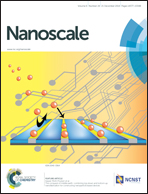Ultra-sensitive detection of leukemia by graphene†
Abstract
Graphene oxide nanoplatelets (GONPs) with extremely sharp edges (lateral dimensions ∼20–200 nm and thicknesses <2 nm) were applied in extraction of the overexpressed guanine synthesized in the cytoplasm of leukemia cells. The blood serums containing the extracted guanine were used in differential pulse voltammetry (DPV) with reduced graphene oxide nanowall (rGONW) electrodes to develop fast and ultra-sensitive electrochemical detection of leukemia cells at leukemia fractions (LFs) of ∼10−11 (as the lower detection limit). The stability of the DPV signals obtained by oxidation of the extracted guanine on the rGONWs was studied after 20 cycles. Without the guanine extraction, the DPV peaks relating to guanine oxidation of normal and abnormal cells overlapped at LFs <10−9, and consequently, the performance of rGONWs alone was limited at this level. As a benchmark, the DPV using glassy carbon electrodes was able to detect only LFs ∼ 10−2. The ultra-sensitivity obtained by this combination method (guanine extraction by GONPs and then guanine oxidation by rGONWs) is five orders of magnitude better than the sensitivity of the best current technologies (e.g., specific mutations by polymerase chain reaction) which not only are expensive, but also require a few days for diagnosis.


 Please wait while we load your content...
Please wait while we load your content...